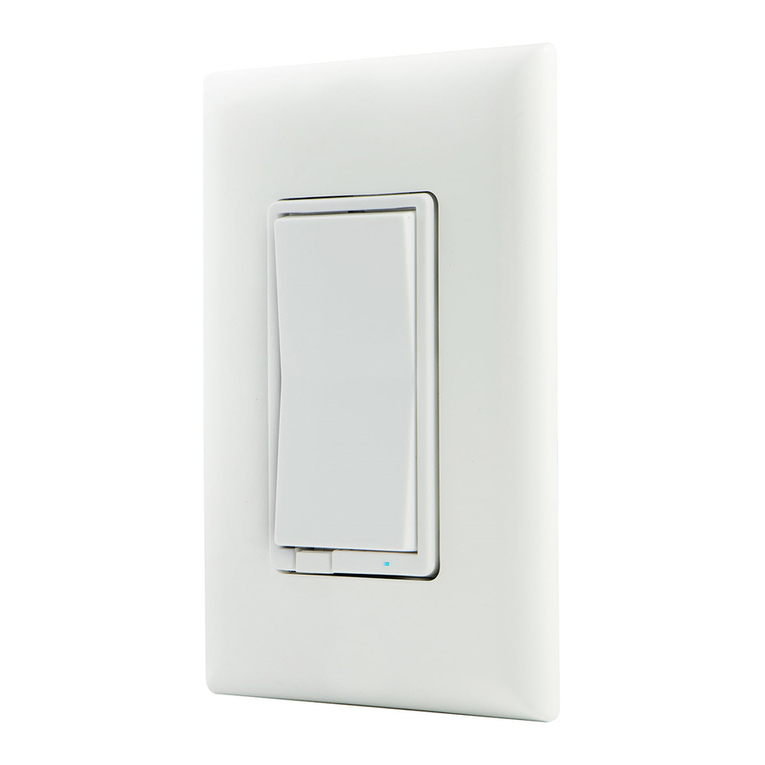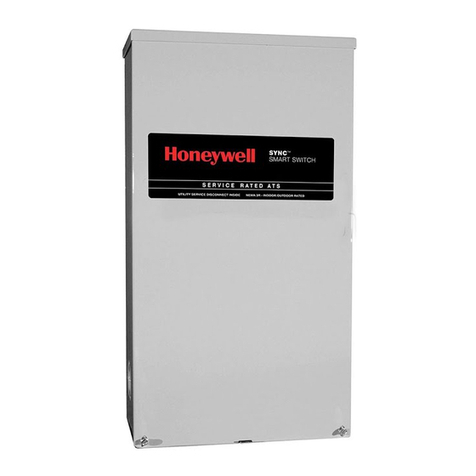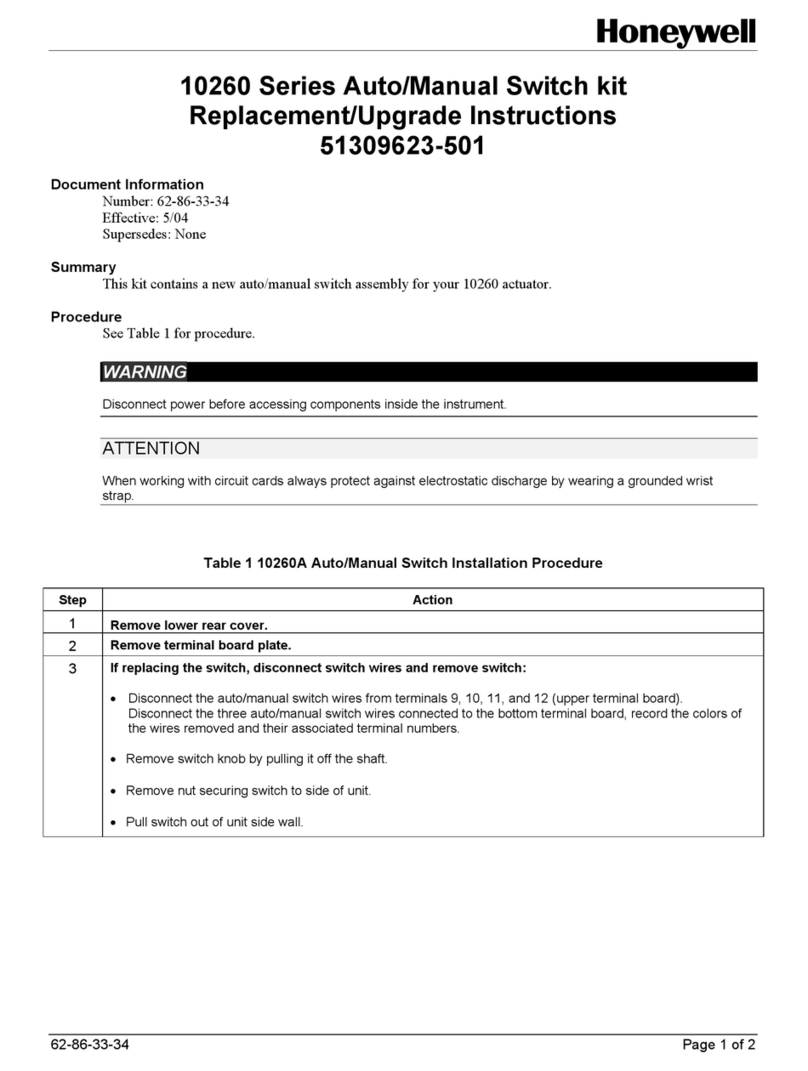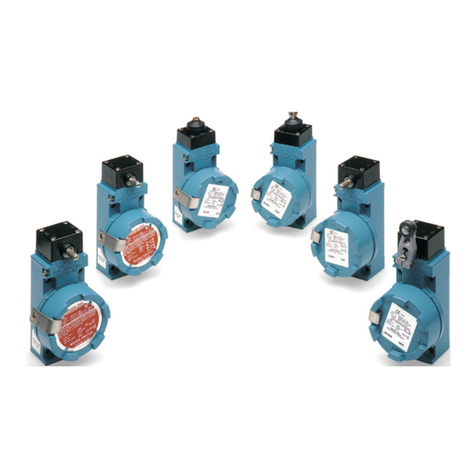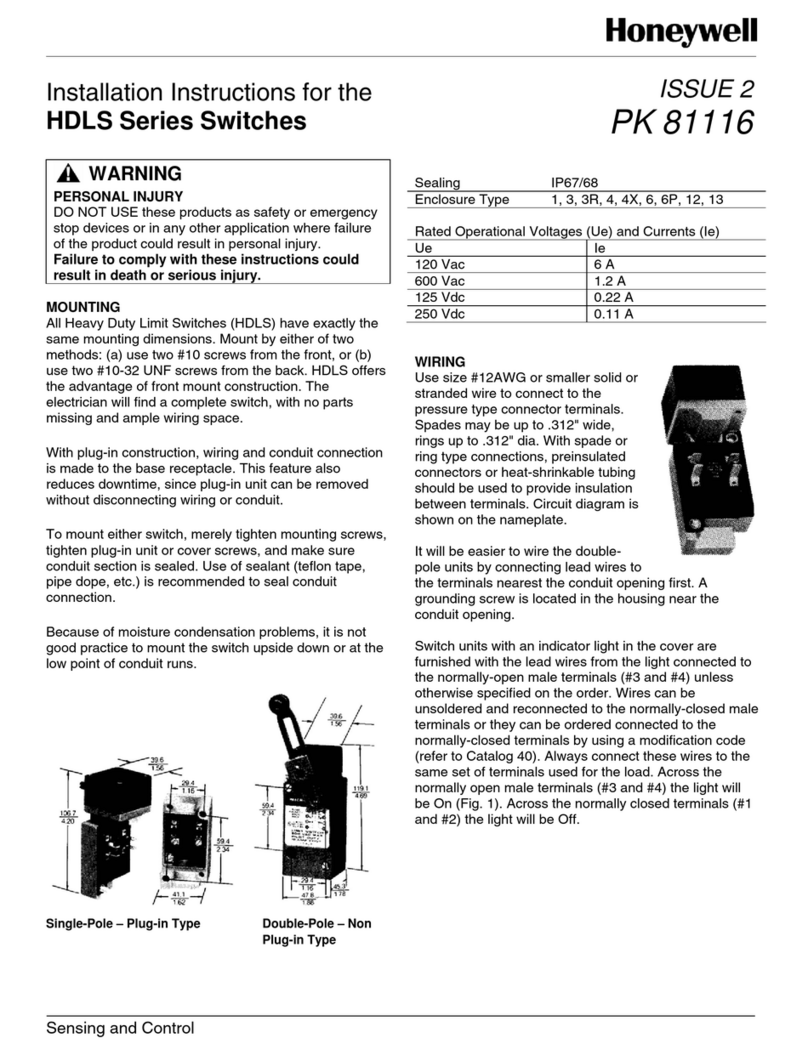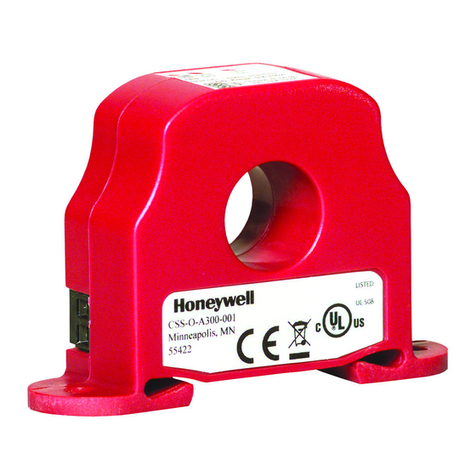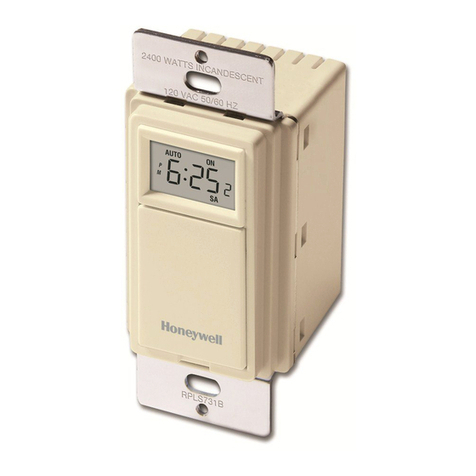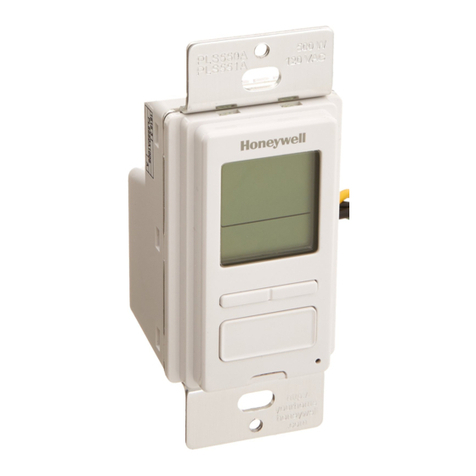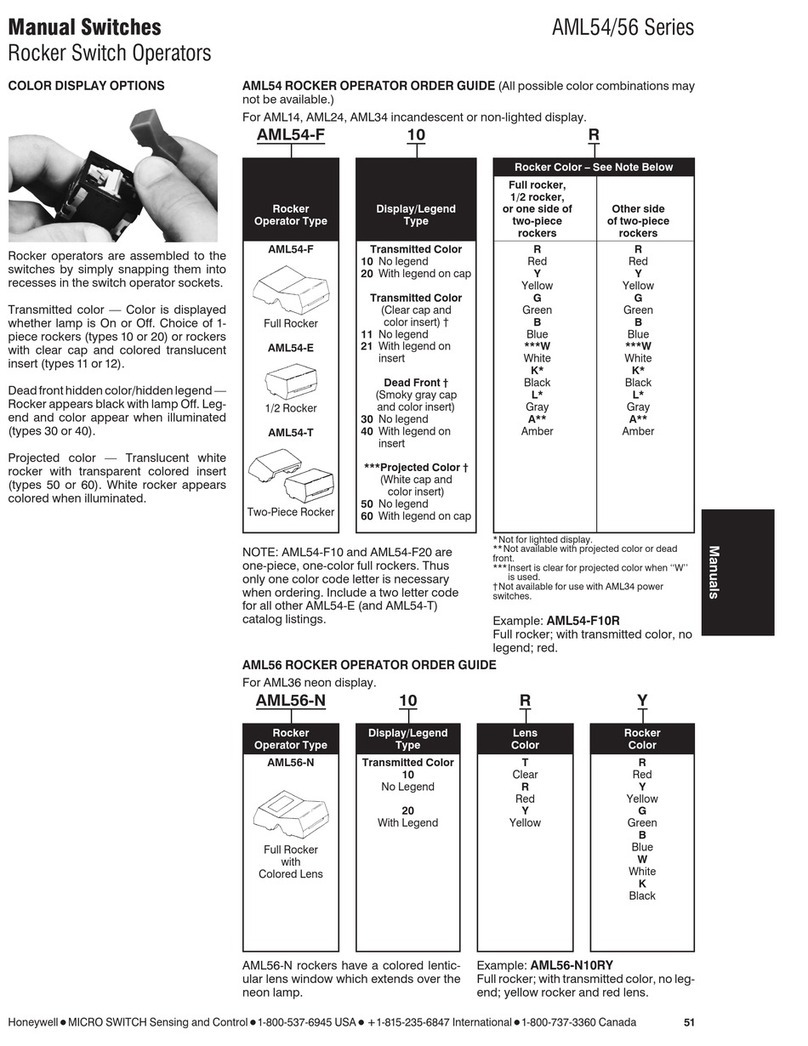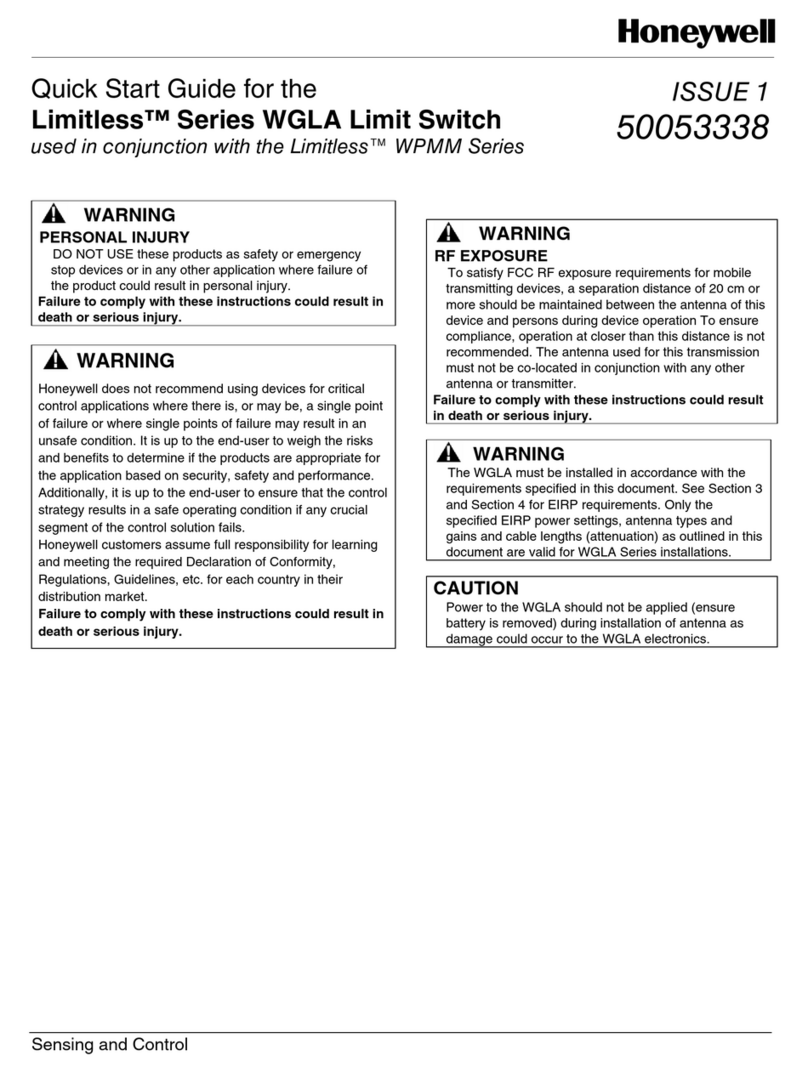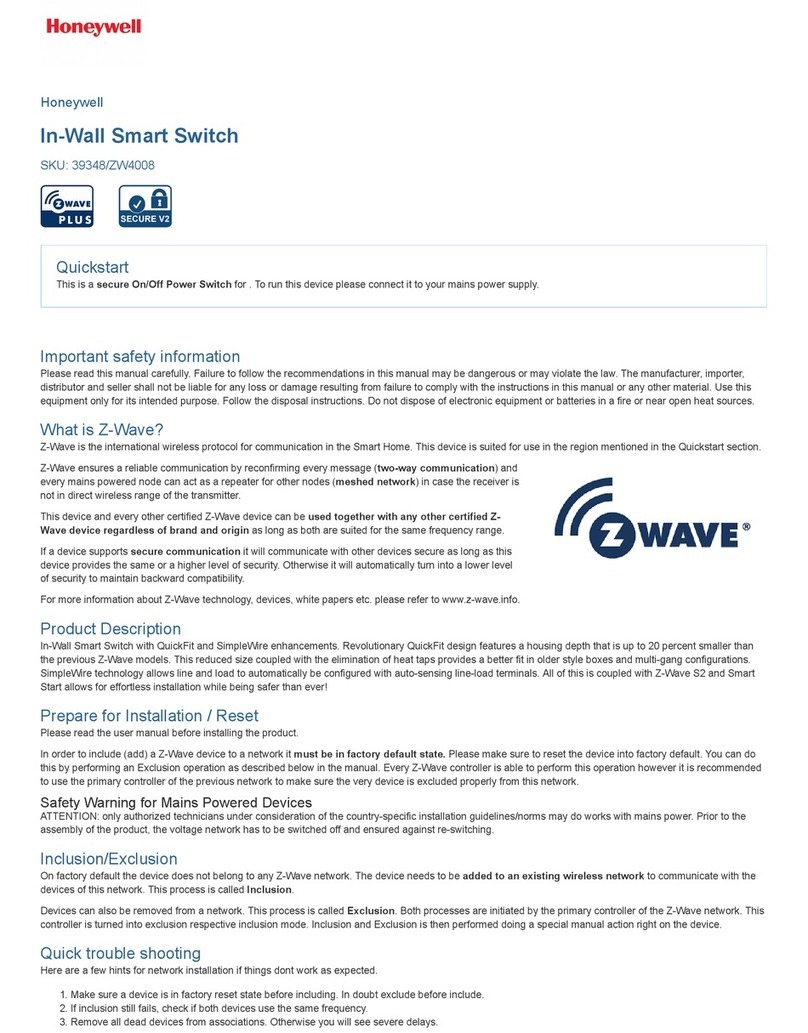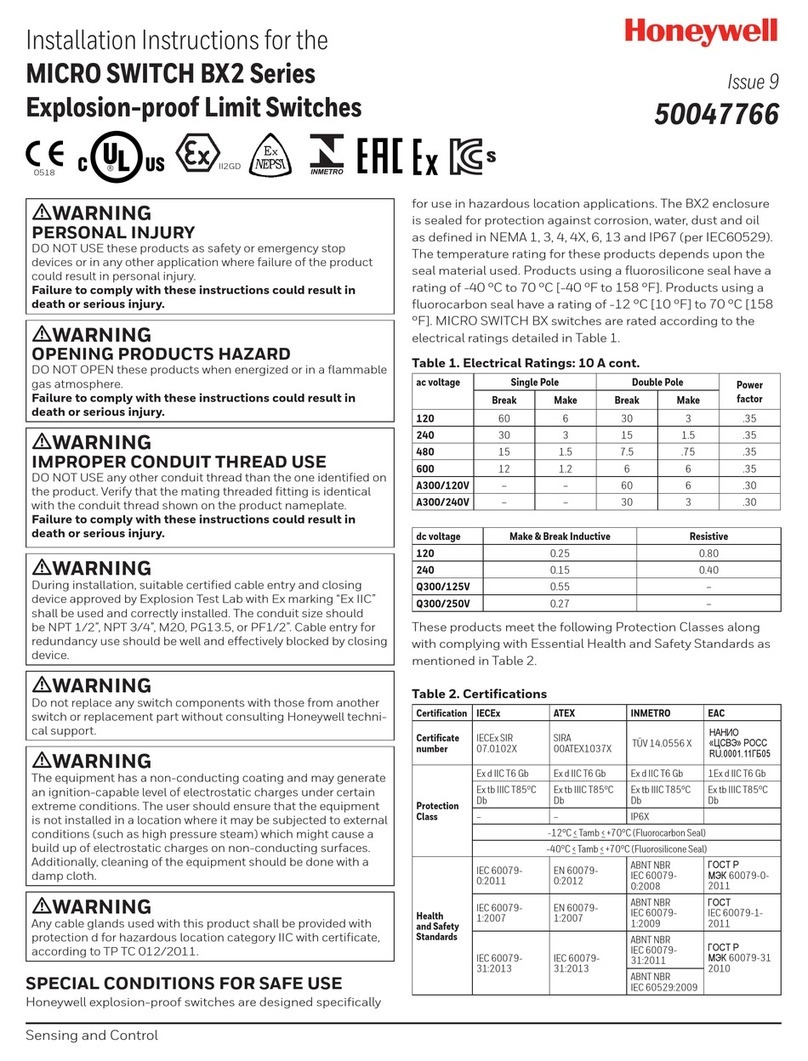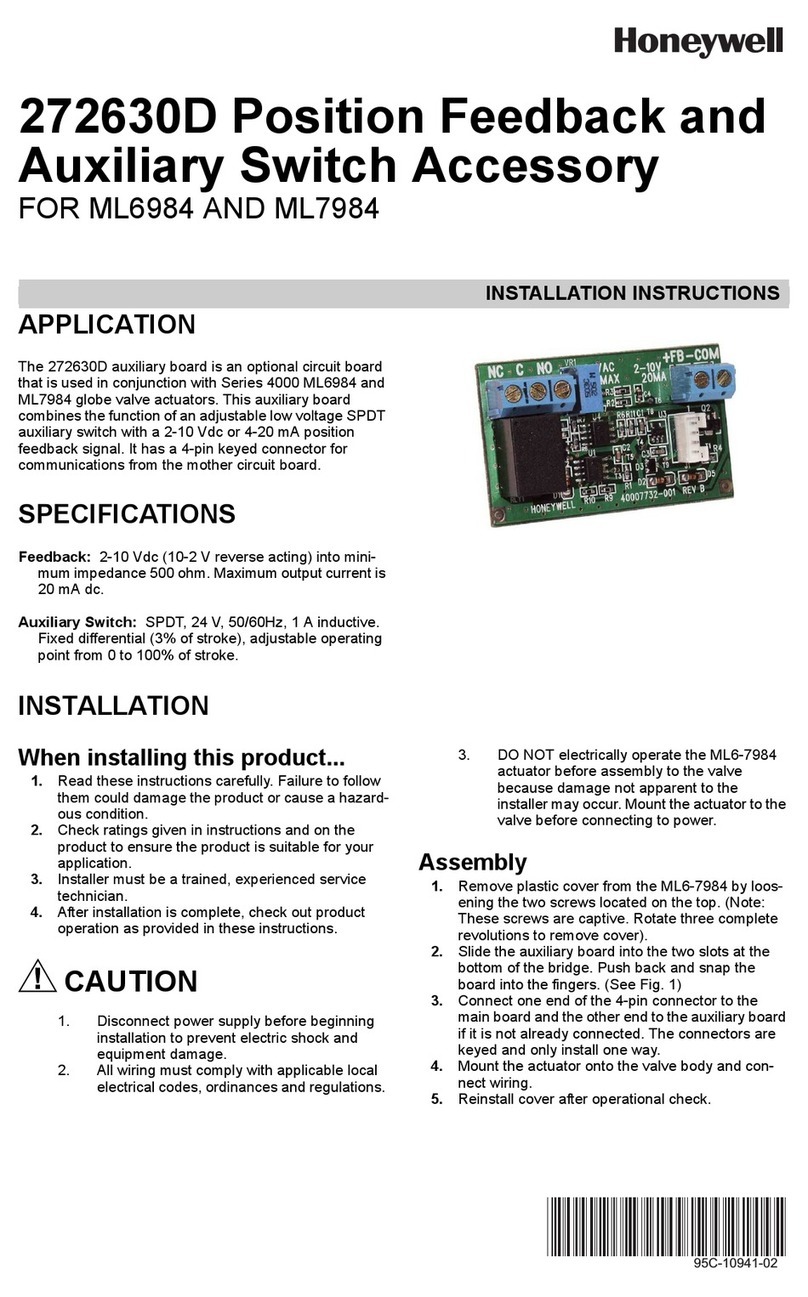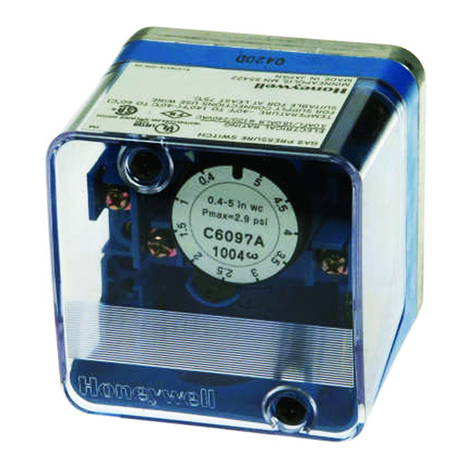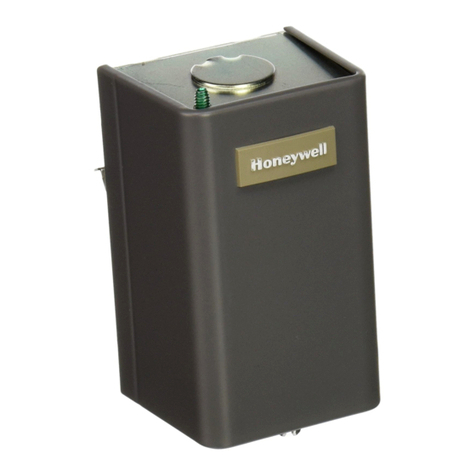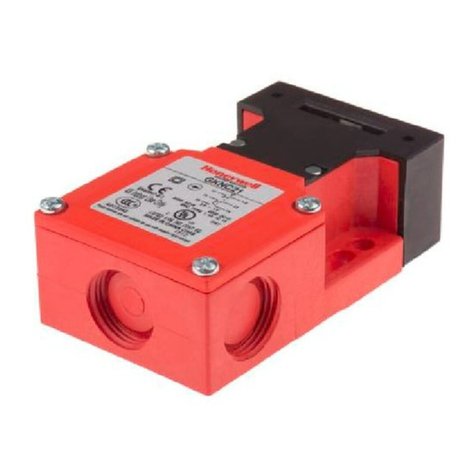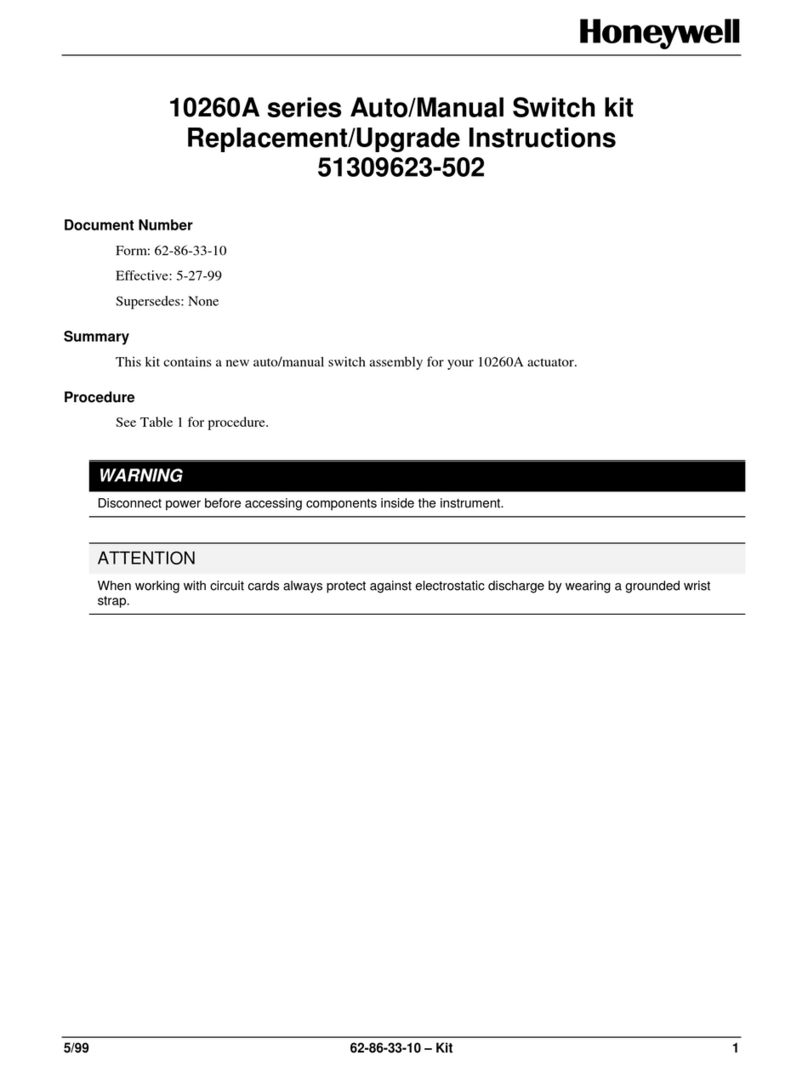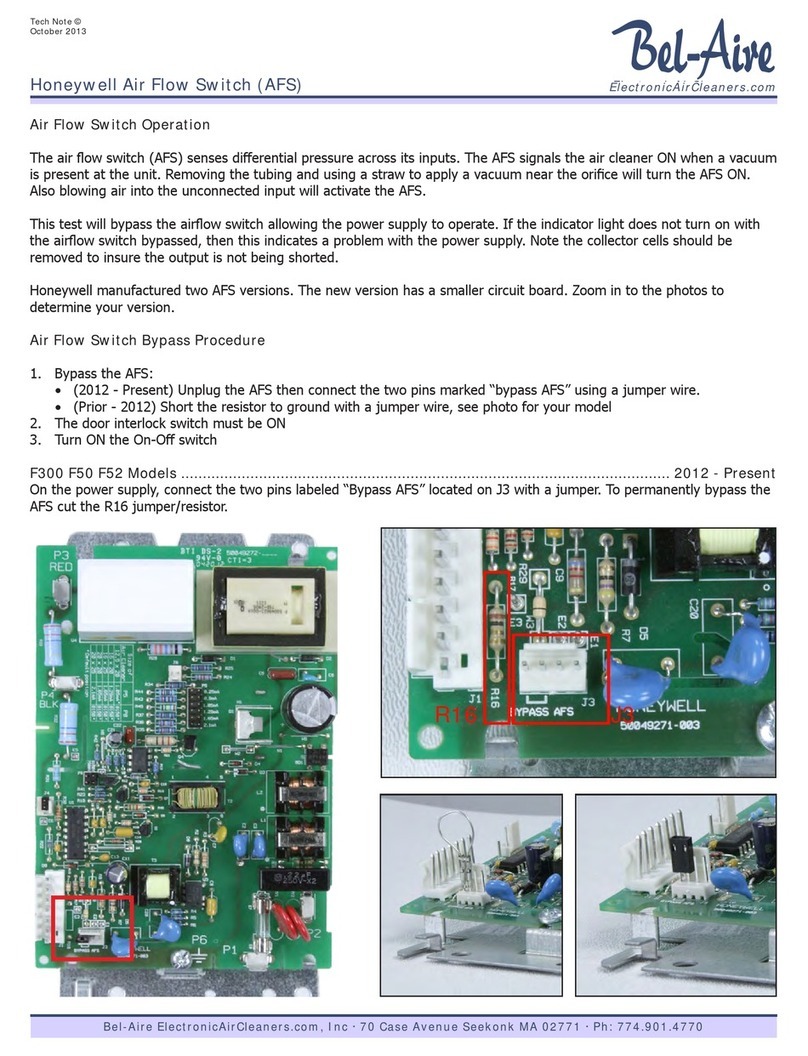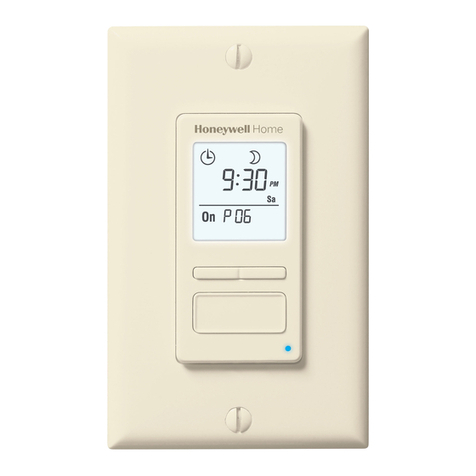IMPORTANT!
3Way switches can be wired in different ways. These instructions explain
the most common method. If you have difficulty with the instructions or your
home wiring, contact a licensed electrician for assistance.
1. Shut off power to the circuit at circuit breaker or fuse box.
IMPORTANT! Verify power is OFF to switch box before continuing.
2. Remove both wallplates.
3. Remove the switch mounting screws.
4. Carefully remove both switches from each switch box location. DO NOT
disconnect the wires yet.
5. Identify switch connected to fuse box. This is the “Line Switch.” Label
wire connected to Common terminal, “LINE.”
6. Identify switch connected to lighting/fixture. This is the “Load Switch.”
Label wire connected to Common terminal, “LOAD.”
OBSERVE IMPORTANT WIRING INFORMATON
IMPORTANT! This switch is rated for and intended to only be used with copper wire.
WIRE GAUGE REQUIREMENTS
Use 14 AWG or larger wires suitable for at least 80° C for supplying Line
(HOT), Load, Neutral, Ground and Traveler connections.
WIRE STRIP LENGTH:
7. For attachment to screw terminals: strip insulation 1” (25mm).
8. For attachment using the enclosure’s holes: strip insulation 5/8” (16mm).
UL specifies that the tightening torque for the screws is
14 Kgf-cm (12 lbf-in).
SWITCH CONNECTED TO FUSE BOX “LINE SWITCH”
(REPLACING STANDARD SWITCH WITH HONEYWELL PRIMARY SWITCH)
9. Disconnect all wires on existing switch.
10. Locate neutral wires found inside switch box. Remove wire nut securing
them (A). (These are typically a bundle of white wires in the back of the box.)
11. Locate jumper wire (included in packaging of primary switch). Connect
with neutral wires and secure again with wire nut previously removed (A).
12. Connect opposite end of jumper wire to NEUTRAL terminal on Primary
Switch (B).
13. Connect wire you previously labeled, “LINE” to LINE terminal on
Primary Switch (C).
14. Connect ground wire (bare/copper/green) to GROUND terminal on
Primary Switch (D).
15. Connect one of the two remaining wires (T1) to LOAD terminal on
Primary Switch (E). Write down the color of the wire. You will need this
when installing the Add-on switch.
16. Connect the remaining wire (T2) to TRAVELER terminal on the Primary
Switch (F).
SWITCH CONNECTED TO LIGHTING “LOAD SWITCH”
(REPLACING STANDARD SWITCH WITH HONEYWELL ADDON SWITCH)
17. Disconnect all wires on existing switch.
18. Locate neutral wires found inside switch box. Remove wire nut
securing them (AA). (These are typically a bundle of white wires in the
back of the box.)
19. Locate jumper wire (included in packaging of primary switch). Connect with
neutral wires and secure again with wire nut previously removed (AA).
20. Connect opposite end of jumper wire to NEUTRAL terminal on Add-on
Switch (BB).
21. Connect ground wire (bare/copper/green) to GROUND terminal on
Add-on Switch (CC).
22. Locate the same colored wire you wrote down previously in the switch
box (T1). Using a wire nut, secure it only to the wire you previously
labeled, “LOAD.”
23. Connect the remaining wire to TRAVELER terminal on the Add-on
Switch (DD). This will be the same color as the wire connected to
TRAVELER terminal on the primary switch.
ATTACH SWITCH TO BOX
24. Carefully place both switches into their respective switch box, being
careful not to pinch or crush wires.
25. Secure each switch to the box using the supplied screws.
26. Mount each switch wallplate.
27. Reapply power to the circuit at fuse box or circuit breaker and test
the system.
WARNING — SHOCK HAZARD
Turn OFF the power to the branch circuit for the switch and lighting fixture at the service
panel. All wiring connections must be made with the POWER OFF to avoid personal injury
and/or damage to the switch. This device is intended for installation in accordance with the
National Electric Code and local regulations in the United States, or the Canadian Electrical
Code and local regulations in Canada. If you are unsure or uncomfortable about performing
this installation consult a qualified electrician.
SINGLE, DUAL AND TRIPLEGANG BOXES
When installing the add-on switch in multiple gang boxes it may be
necessary to break off one or both sides of the scored tabs on the front yoke.
Scan to view installation guide
Balayez ce code pour consulter le guide d’installation
Escanear para ver la guía de instalación
www.honeywellelectricalaccessories.com
39350
ZW2004
A. Neutral (White)
B. Traveler (Red/Other)
C. Ground (Green/Bare)
D. The Add-on switch takes
the characteristics of the
primary switch. Refer to the
primary switch’s manual for
instructions.
TOOLS INSTALLATION1 3
1.
CHANGING THE COLOR OF THE PADDLE
This step is optional. Before you start you may want to change the color of
the paddle to match your wallplate or decor.
1. Push side tabs in on one side and then the other to release paddle. Lift
the cover up and off.
2. Simply put the new paddle onto the switch by side tabs and
snap securely into place.
Once this step has been completed please proceed to Section 3.
2CUSTOMIZATION
1 1 2 3
25 26 27 27
ADD-ON SWITCH
IN-WALL
INTERRUPTOR AUXILIAR
DE LA PARED
INTERRUPTEUR SUPPLÉMENTAIRE
DANS LE MUR
JASCO Products warrants this product to be free from manufacturing defects for a period
of two years from the original date of consumer purchase. This warranty is limited to
the repair or replacement of this product only and does not extend to consequential or
incidental damage to other products that may be used with this product. This warranty is
in lieu of all other warranties, expressed or implied. Some states do not allow limitations
on how long an implied warranty lasts or permit the exclusion or limitation of incidental
or consequential damage, so the above limitations may not apply to you. This warranty
gives you specific rights and you may also have other rights which vary from state to state.
Please contact Customer Service at 8556988324 between 7AM – 8PM CST or via our
website (www.byjasco.com) if the unit should prove defective within the warranty period.
JASCO Products garantit que ce produit est exempt de tout défaut de fabrication pour une
période de deux ans à compter de la date de l’achat original par l’acheteur. Cette garantie
se limite exclusivement à la réparation ou au remplacement de ce produit et n’est pas
applicable aux dommages indirects ou accessoires survenus sur d’autres produits utilisés
avec ce produit. Cette garantie se substitue à toute autre garantie expresse ou implicite.
Certains États ne permettent pas de restrictions quant à la durée d’une garantie implicite
ou permettent l’exclusion ou la limitation des dommages indirects et accessoires; il se
peut, par conséquent, que cette garantie ne s’applique pas dans votre cas. Cette garantie
vous confère des droits juridiques précis; vous pouvez jouir d’autres droits qui peuvent
varier d’un État à l’autre. Veuillez communiquer avec le service à la clientèle au 1855
6988324 entre 7 h et 20 h (heure normale du Centre) ou par l’intermédiaire de notre site
web (www.byjasco.com) si l’appareil s’avère défaillant au cours de la période de garantie.
JASCO Products garantiza que este producto está libre de defectos de fabricación durante
un periodo de dos años a partir de la fecha original de compra por parte del consumidor.
Esta garantía se limita a la reparación o sustitución de este producto solamente y no se
extiende a daños derivados o accidentales causados a otros productos que se usen con
esta unidad. Esa garantía remplaza a todas las demás garantías expresas o implícitas.
Algunos estados no autorizan limitaciones en cuanto a la duración de una garantía
implícita ni permiten la exclusión o limitación por daños accidentales o derivados; por
lo tanto, puede que las anteriores limitaciones no apliquen en su caso. Esta garantía le
da a usted derechos específicos, y otros que usted puede tener y que varían según el
estado en el que usted reside. Si la unidad resultare defectuosa dentro del periodo de
garantía, comuníquese por favor con Atención al Cliente en el 8556988324 entre 7
y 20 h, Hora del Centro, o a través de nuestro sitio de internet (www.byjasco.com).
JASCO Products Company LLC, Building B
10 E. Memorial Rd. Oklahoma City, OK 73114.
ZW2004
Power: 120 VAC, 60 Hz.
Operating Temperature Range: 32104° F (040° C)
For indoor use only.
Specifications subject to change without notice due to continuing product improvement
ZW2004
Tension : 120 VCA, 60 Hz.
Plage de températures de fonctionnement : de 32 à 104 °F (de 0 à 40 °C).
Utilisation intérieure uniquement.
En raison d’améliorations continues du produit, les spécifications
peuvent faire l’objet de changements sans préavis.
ZW2004
Alimentación: 120 VAC, 60 Hz
Rango de temperatura de funcionamiento: 32104 °F (040 °C).
Para espacios interiores solamente.
Especificaciones sujetas a cambio sin aviso debido a continuas mejoras del producto
SPECIFICATIONS
IMPORTANT!
SPÉCIFICATIONS
ESPECIFICACIONES
WARRANTY
GARANTIE
GARANTÍA
B
A
D
C
The Add-on switch is not wireless enabled and must be used exclusively
with one of the Honeywell wireless devices. It is not designed for standalone
use to control an electrical load. It does not have wireless functionality
and does not act as a repeater in your wireless control network
Jasco Products Company LLC.
10 E. Memorial Rd.,
Oklahoma City, OK 73114
The Honeywell Trademark is used under license
from Honeywell International Inc.
Honeywell International Inc. makes no representation or warranties with
respect to this product.
This product is manufactured by Jasco Products Company LLC.
MADE IN CHINA/FABRIQUÉ EN CHINE/ HECHO EN CHINA
©JASCO 2018 | 39350 | ZW2004 | 11/30/17 v1
All brand names shown are
trademarks of their respective owners.
Tous les noms de marque illustrés
sont des marques de commerce
de leurs propriétaires respectifs.
Todas las marcas que aparecen
aquí son marcas registradas
de sus respectivos dueños
L’interrupteur supplémentaire n’est pas sans fil et doit être utilisé exclusivement avec l’un
des dispositifs sans fil Honeywell. Il n’est pas conçu pour être utilisé de façon autonome
en vue de commander une charge électrique. Il n’est pas équipé de la fonction sans
fil et il ne joue pas le rôle de répétiteur dans votre réseau de commande sans fil.
El interruptor auxiliar no tiene funcionalidad inalámbrica y se debe utilizar únicamente
con uno de los dispositivos inalámbricos Honeywell. No ha sido diseñado para usarse
de manera separada para controlar una carga eléctrica. No tiene funcionalidad
inalámbrica y no funciona como repetidor en una red de control inalámbrico.
IMPORTANT!
IMPORTANTE!
10
5 9
23
6
STANDARD 3WAY SWITCH WIRING
LINE
SWITCH
OUT TO ;LOAD
SWITCH
OUT TO ;LIGHT
(LOAD)
FROM BREAKER BOX IN FROM LINE SWITCH
LOAD
SWITCH
HONEYWELL ADDON SWITCH WIRING
LINE SWITCH
(PRIMARY SWITCH)
LOAD SWITCH
(ADD ON SWITCH)
OUT TO LIGHT (LOAD)
FROM BREAKER BOX
LINE
LINE
NEUTRAL JUMPER
GROUND
NEUTRAL
NEUTRAL
LOAD
LOAD
GROUND
IN FROM LINE SWITCH
T2
T2
T2 T2
T2
T2 T1
T1
T1
T1
T1
T1
D
E
C
F
B
A
A
AA
AA
CC
DD
BB
NEUTRAL JUMPER
-
COMMONCOMMON
RISK OF FIRE
RISK OF ELECTRICAL SHOCK
RISK OF BURNS
CONTROLLING APPLIANCES:
CAUTION:
•DO NOT EXCEED RATINGS
•DO NOT USE TO CONTROL ANY DEVICE
WHERE UNINTENDED OPERATION
COULD CAUSE UNSAFE CONDITIONS
(HEAT LAMP, SUN LAMP, ETC.)
•DO NOT USE TO CONTROL
RECEPTACLES
•FOR INDOOR USE ONLY
RISQUE D’INCENDIE
RISQUE DE CHOC ÉLECTRIQUE
RISQUE DE BRÛLURES
COMMANDE DES APPAREILS :
ATTENTION :
•NE PAS DÉPASSER LES
CARACTÉRISTIQUES NOMINALES
•NE PAS UTILISER POUR COMMANDER
DES APPAREILS POUR LESQUELS
UN FONCTIONNEMENT IMPRÉVU
POURRAIT ENTRAÎNER DES
CONDITIONS DANGEREUSES (LAMPE
INFRAROUGE, LAMPE SOLAIRE, ETC.)
•NE PAS UTILISER POUR COMMANDER
DES PRISES DE COURANT
•POUR UTILISATION INTÉRIEURE
UNIQUEMENT
RIESGO DE INCENDIO
RIESGO DE DESCARGA ELÉCTRICA
RIESGO DE QUEMADURAS
CONTROL DE APARATOS:
PRECAUCIÓN:
•NO SUPERAR LOS VALORES
NOMINALES ELÉCTRICOS.
•NO USAR PARA CONTROLAR
DISPOSITIVOS EN LOS QUE
EL FUNCIONAMIENTO NO
INTENCIONADO PODRÍA PROVOCAR
SITUACIONES PELIGROSAS
(LÁMPARAS DE CALEFACCIÓN,
LÁMPARAS SOLARES, ETC.)
•NO UTILIZAR EL DISPOSITIVO PARA
CONTROLAR TOMACORRIENTES
•PARA USO EN INTERIORES
EXCLUSIVAMENTE
WARNING
AVERTISSEMENT
ADVERTENCIA
NOT FOR USE WITH MEDICAL OR
LIFE SUPPORT EQUIPMENT
ZWAVE ENABLED DEVICES SHOULD
NEVER BE USED TO SUPPLY
POWER TO, OR CONTROL THE ON/
OFF STATUS OF MEDICAL AND/
OR LIFE SUPPORT EQUIPMENT.
NE PAS UTILISER AVEC UN
ÉQUIPEMENT MÉDICAL
OU DE SURVIE
LES DISPOSITIFS COMPATIBLES
AVEC LA TECHNOLOGIE ZWAVE NE
DEVRAIENT JAMAIS ÊTRE UTILISÉS
POUR ALIMENTER OU COMMANDER
LA MISE EN MARCHE OU L’ARRÊT DE
L’ÉQUIPEMENT MÉDICAL OU DE SURVIE.
SE PROHÍBE SU EMPLEO EN
EQUIPO MÉDICO O EQUIPO
PARA EL MANTENIMIENTO DE
LAS FUNCIONES VITALES
LOS DISPOSITIVOS ZWAVE NUNCA
SE DEBEN USAR PARA SUMINISTRAR
ENERGÍA ELÉCTRICA, NI PARA
CONTROLAR EL ESTADO DE ENCENDIDO
O APAGADO DEL EQUIPO MÉDICO Y/O
EL EQUIPO PARA EL MANTENIMIENTO
DE FUNCIONES VITALES.
If you have any problems or questions, contact our tech support
team at 18556988324, MondayFriday, 7AM8PM CST.
For the most up-to-date product support, accessories, electronic
(PDF) format manuals and more, visit www.byjasco.com/support.
• No user serviceable parts in this unit.
Si vous avez des problèmes ou des questions, communiquez
avec notre équipe de soutien technique au 18556988324,
du lundi au vendredi, de 7 h à 20 h (HNC).
Pour un soutien technique d’avant-garde, les nouveaux accessoires,
les plus récents manuels en format électronique (PDF) et
plus encore, visitez le site www.byjasco.com/support.
• Aucune des pièces de ce dispositif ne peut être réparée par l’utilisateur.
Si tiene problemas o dudas, comuníquese con nuestro equipo
técnico al número: 18556988324, de lunes a viernes,
de 7.00 a 20.00, hora estándar del centro (CST).
Para recibir el soporte técnico más actualizado sobre productos, accesorios,
manuales en formato digital (PDF), entre otros, visite www.byjasco.com/support
• Esta unidad no contiene piezas que el usuario pueda reparar.
DO NOT RETURN THIS
PRODUCT TO THE STORE
NE RETOURNEZ PAS CE
PRODUIT AU MAGASIN
NO DEVUELVA ESTE
PRODUCTO A LA TIENDA
STOP
